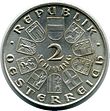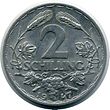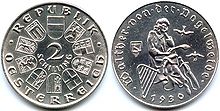Doppelschilling (Austria)
Double shillings are coins from Austria with a value of two shillings .
In Austria, double shillings are primarily understood to be a ten-part series of silver commemorative coins worth two shillings from the interwar period . The series can be divided into two parts (1928–1932 and 1933–1937), thus reflecting political developments in Austria. At first glance, this break catches the eye with the different front pages (value pages). In the first phase, the front shows the value, surrounded by the Austrian shield and the coats of arms of the nine federal states, as well as the legend "REPUBLIC OF AUSTRIA". During the second phase, the new coat of arms of the Austrian corporate state replaced a nimbated double-headed eagle covered with a shieldthe heraldic circle. The legend only reads AUSTRIA, below you can find the value and the divided year.
The backs are consistently dedicated to Austrian motifs, all of which refer to famous personalities, although here too a paradigm shift began in 1933. The prelude in 1928 was a coin to mark the 100th anniversary of the death of the composer Franz Schubert . Other artists and scientists followed: Theodor Billroth (1929), Walther von der Vogelweide (1930), Wolfgang Amadeus Mozart (1931) and Joseph Haydn (1932). The piece on Walther von der Vogelweide is particularly noteworthy . Its reverse was designed by E. Smith and in the same year it was also used in Germany for a 3 Reichsmark coin for the same occasion.
After only long deceased people from the arts and sciences could be found on the Doppelschillingen, two recently deceased politicians from the corporate state, Ignaz Seipel and Engelbert Dollfuß , appeared on the coins in 1933 and 1934 , including the pieces on Karl Lueger (1935) and Prinz Eugen (1936) are to be understood as political statements. Even the last piece in this series on the baroque architect Johann Bernhard Fischer von Erlach (1937) has a political component, as it does not show the architect, but as the only one from the series a building - the Karlskirche in Vienna - and thus underlines the close connection between Church and State.
After the Second World War, another 2 shilling coin came out. However, this was a pure aluminum coin in circulation . On the coat of arms side, it shows the new one-headed federal eagle with a wall crown, hammer, sickle and broken chains, again surrounded by the legend "REPUBLIC OF AUSTRIA". The value side, on the other hand, gives the year and is adorned with two ears of wheat and a bunch of grapes - two important goods in the post-war period.
Overview of the individual issues
The following is an overview of the minted specimens of the 2 shilling coin.
| Illustration | Reason, if necessary, explanation of the presentation |
issue year |
Draft of the image side |
Embossed edition |
|
|---|---|---|---|---|---|
| Value side | Image side | ||||
|
Material: 64.0% silver, 36.0% copper - coin diameter: 29 mm - rough weight: 12 g - fine weight 7.68 g Edge: grooved |
|||||

|

|
100th year of death of Franz Schubert | 1928 | Edwin Grienauer | 6,900,000 |

|

|
100th year of birth of Theodor Billroth | 1929 | Edwin Grienauer | 2,000,000 |

|

|
700th year of death of Walther von der Vogelweide | 1930 | Eddy Smith | 500,000 |

|

|
175th year of birth of Wolfgang Amadeus Mozart | 1931 | Edwin Grienauer | 500,000 |

|

|
200th year of birth of Joseph Haydn | 1932 | Edwin Grienauer | 300,000 |

|

|
Dr. Ignaz Seipel | 1933 | Eduard Hanisch-Concée | 400,000 |

|

|
Dr. Engelbert Dollfuss | 1934 | Edwin Grienauer | 1,500,000 |

|

|
25th year of death of Dr. Karl Lueger | 1935 | Rudolf Marshal | 500,000 |

|

|
200th year of death of Prince Eugene of Savoy | 1936 | Edwin Grienauer | 500,000 |

|

|
JB Fischer von Erlach Illustration from the Karlskirche in Vienna |
1937 | Edwin Grienauer | 500,000 |
|
Material: 98.5% aluminum, 1.5% magnesium - coin diameter: 28 mm - rough weight: 2.8 g Edge: smooth |
|||||

|

|
Course coin | 1946 | Michael Powolny | 10,082,000 |

|

|
Course coin | 1947 | Michael Powolny | 20,140,000 |

|

|
Course coin | 1952 | Michael Powolny | 148,500 |
literature
- Klaus Liebscher and Wilfried Seipel (eds): From the Schilling to the Euro Continuity and stability. Series: Exhibition catalog Kunsthistorisches Museum. 1st edition, Vienna 2002.
- Tyll Kroha: Large encyclopedia of numismatics. Gütersloh 1997.
Individual evidence
- ↑ Austria coin catalog Austria . Verlag Christine Steyrer, 2012, ISBN 978-3-902662-18-7 , p. 109-110 .
- ^ Coins and medals from Austria. Retrieved September 10, 2015 .
- ↑ 2 Schilling 1946, aluminum. Retrieved January 1, 2017 .

